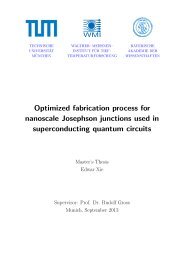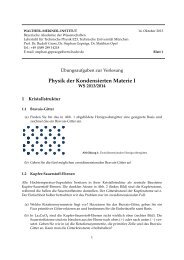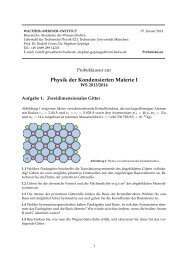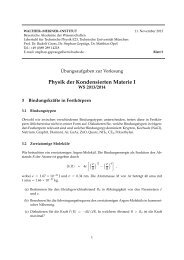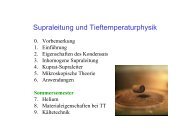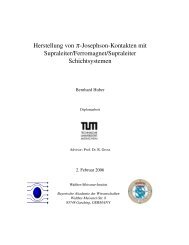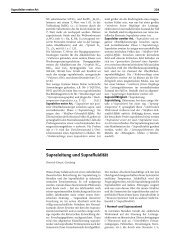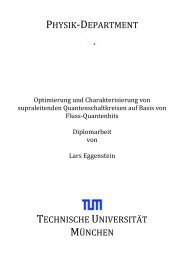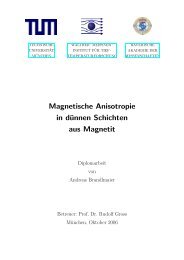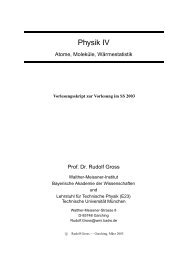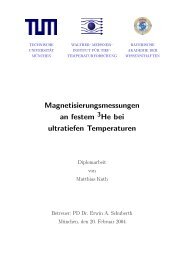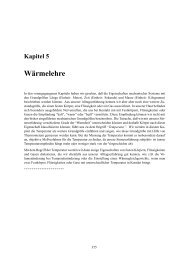Surface magneto-plasmons in magnetic multilayers - Walther ...
Surface magneto-plasmons in magnetic multilayers - Walther ...
Surface magneto-plasmons in magnetic multilayers - Walther ...
You also want an ePaper? Increase the reach of your titles
YUMPU automatically turns print PDFs into web optimized ePapers that Google loves.
Section 2.3<br />
Reflectivity of surface <strong>plasmons</strong> 17<br />
2.3.2 <strong>Surface</strong> <strong>plasmons</strong> at rough surfaces<br />
For smooth surfaces, surface <strong>plasmons</strong>, excited at the metal-air <strong>in</strong>terface, cannot<br />
radiate light <strong>in</strong>to air or vacuum as it is depicted <strong>in</strong> Fig. 2.2(b). There it is shown that<br />
surface <strong>plasmons</strong> at an air-metal <strong>in</strong>terface have a greater wave vector than light and<br />
thus are "nonradiative" surface <strong>plasmons</strong>. This changes when the surface has af<strong>in</strong>ite<br />
roughnesses.<br />
To understand why surface <strong>plasmons</strong> can radiate light <strong>in</strong>to air when the surface is<br />
rough, it has to be mentioned that surface <strong>plasmons</strong> can also be excited by a grat<strong>in</strong>g<br />
coupler [37, 9, 22]. Then to the wave vector kx a ∆kx is added which depends on the<br />
grat<strong>in</strong>g constant. The sum of both can then fulfil the dispersion relation.<br />
kx + ∆kx = ω<br />
c s<strong>in</strong> θ ± ∆kx = kSPP<br />
(2.36)<br />
With a grat<strong>in</strong>g coupler not only surface <strong>plasmons</strong> can be excited, but also the <strong>in</strong>verse<br />
can take place, surface <strong>plasmons</strong> propagat<strong>in</strong>g along a grat<strong>in</strong>g can transform <strong>in</strong>to light.<br />
Of course, rough surfaces are not periodic like a grat<strong>in</strong>g but rather show a statistical<br />
distribution. Nevertheless, due to surface roughness light is radiated from the metal<br />
surface <strong>in</strong>to air by surface <strong>plasmons</strong> [38, 39]. In a simple picture this can be expla<strong>in</strong>ed<br />
by scatter<strong>in</strong>g of surface <strong>plasmons</strong> at roughnesses. Due to the scatter<strong>in</strong>g the wave<br />
vector of the surface <strong>plasmons</strong> changes so that it matches the light wave vector and<br />
surface <strong>plasmons</strong> can transform <strong>in</strong>to light. In a more mathematical consideration<br />
a Fourier transformation of the statistical distribution yields not only one ∆kx like<br />
for a grat<strong>in</strong>g coupler but a cont<strong>in</strong>uum of ∆kx. With this Fourier transformation<br />
a correlation function f(∆kx) is <strong>in</strong>troduced which is then solved for the ∆kx by<br />
perturbation calculations [40, 9, 22].<br />
The effects of surface roughnesses on the reflectivity R p are a broaden<strong>in</strong>g of the<br />
resonance dip as well as a shift of θSPP to larger angles [41]. Further effects on R p will<br />
be regarded when the measurements are dicsussed.<br />
2.3.3 Reflectivity at a multilayer system<br />
As shown <strong>in</strong> Sect. 2.3.1 the reflectivity for a s<strong>in</strong>gle layer can easily be derived by<br />
summ<strong>in</strong>g up all light paths <strong>in</strong> the layer. To calculate the reflectivity of a system<br />
consist<strong>in</strong>g of n layers, Fig. 2.4 has to be extended as shown <strong>in</strong> Fig. 2.6. Now, the<br />
reflectivity at an <strong>in</strong>terface i is given not only by the reflection coefficient of the ith



